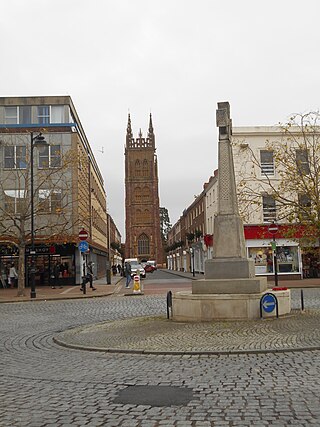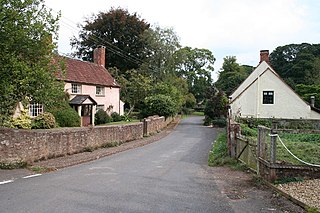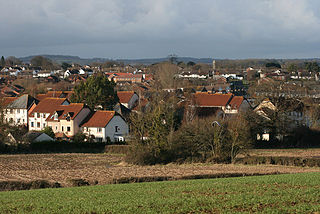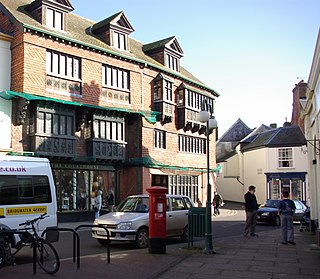
Taunton is the county town of Somerset, England. It is a market town and has a minster church. Its population in 2011 was 64,621. Its thousand-year history includes a 10th-century monastic foundation, Taunton Castle, which later became a priory. The Normans built a castle owned by the Bishops of Winchester. Parts of the inner ward house were turned into the Museum of Somerset and Somerset Military Museum. For the Second Cornish uprising of 1497, Perkin Warbeck brought an army of 6,000; most surrendered to Henry VII on 4 October 1497. On 20 June 1685 in Taunton the Duke of Monmouth crowned himself King of England in a rebellion, defeated at the Battle of Sedgemoor. Judge Jeffreys led the Bloody Assizes in the Castle's Great Hall.

Taunton Deane was a local government district with borough status in Somerset, England. Its council was based in Taunton.

West Somerset was a local government district in the English county of Somerset from 1974 to 2019. The council covered a largely rural area, with a population of 34,900 in an area of 740 square kilometres (290 sq mi); it was the least populous non-unitary district in England. According to figures released by the Office for National Statistics in 2009, the population of West Somerset had the oldest average age in the United Kingdom at 52. The largest centres of population were the coastal towns of Minehead and Watchet (4,400).

Wellington is a market town in Somerset, England. It is situated 7 miles (11 km) south west of Taunton, near the border with Devon, which runs along the Blackdown Hills to the south of the town. The town had a population of 14,549, which includes the residents of the parish of Wellington Without, and the villages of Tone and Tonedale.

Combe Florey is a village and civil parish in Somerset, England, situated 6 miles (9.7 km) northwest of Taunton, on the West Somerset Railway. The village has a population of 261. The parish includes the hamlet of Eastcombe which is a linear settlement along the A358 Taunton-Wiliton Road.

Bishop's Hull is a village and civil parish in Somerset, England, in the western suburbs of Taunton. It includes the areas of Rumwell, Rumwell Park, Roughmoor and Longaller and is close to the River Tone. The parish, which includes the hamlet of Netherclay, has a population of 2,975 in total.

Comeytrowe is a south western suburb of Taunton and former civil parish, now in the parish of Taunton in the county of Somerset, England. In 2011 the parish had a population of 5,463. The parish included the area of Galmington.

Ruishton is a village and civil parish in Somerset, England, situated on the River Tone and A358 road 2 miles (3.2 km) east of Taunton. The village has a population of 1,473. The parish includes the hamlet of Henlade.

Wiveliscombe is a town and civil parish in Somerset, England, situated 9 miles (14 km) west of Taunton. The town has a population of 2,893. The Square, fronted by several listed structures, held the former market. The parish includes the nearby hamlet of Maundown.

Richard Huish College is a further education and sixth-form college in Taunton, Somerset, England. Located on a single site in South Road, about a mile from the centre of Taunton, it offers A-level courses, apprenticeships and vocational courses.

King's College is a private co-educational secondary boarding and day school in Taunton, Somerset, England. A member school of the Woodard Corporation, it has approximately 450 pupils aged 13 to 18, including about 300 boarders. Its affiliated prep school is King's Hall School. The head of the school is currently Michael Sloan, who started his first academic year in the winter of 2022.

Taunton School is public school, now co-educational, in the county town of Taunton in Somerset in South West England. It serves boarding and day-school pupils from the ages of 13 to 18.
Taunton Deane Borough Council in Somerset, England was elected every four years. The first elections to the council were held in 1973, ahead of it coming into being in 1974. The last election was held in 2015. The council was abolished in 2019 when the district merged with neighbouring West Somerset district to become Somerset West and Taunton.

The King's School is an 11–18 boys grammar school with academy status, in the market town of Grantham, Lincolnshire, England. The school's history can be traced to 1329, and was re-endowed by Richard Foxe in 1528. Located on Brook Street, the school's site has expanded over the course of its history, with some school buildings dating back to 1497.

Taunton Castle is a castle built to defend the town of Taunton, Somerset, England. It has origins in the Anglo Saxon period and was later the site of a priory. The Normans then built a stone structured castle, which belonged to the Bishops of Winchester. The current heavily reconstructed buildings are the inner ward, which now houses the Museum of Somerset and the Somerset Military Museum. The building was designated a grade I listed building in 1952.

Bishop Fox's School is a mixed secondary school located in Taunton, Somerset, England.

Tottenham Grammar School (TGS) was a grammar school in North London, with local football connections. Its history goes back beyond the 1631 bequest by the Duchess of Somerset. It closed in 1988, but it created the Tottenham Grammar School Foundation.

Vere Poulett, 3rd Earl Poulett, styled The Honourable Vere Poulett until 1764, was an English peer.
James Upton (1670–1749) was an English clergyman, schoolmaster, and literary editor.

County Hall is a municipal building in The Crescent, Taunton, Somerset, England. The structure, which is the offices and meeting place of Somerset Council, is a Grade II Listed building.




















